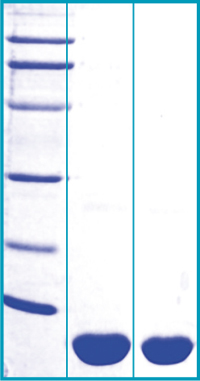Type
Recombinant protein
Description
Total 101 AA. MW: 11.63 kDa (calculated). UniProtKB acc.no. P80511. N-Terminal His-tag, 10 extra AA.
Amino Acid Sequence
MKHHHHHHASTKLEEHLEGIVNIFHQYSVRKGHFDTLSKGELKQLLTKELANTIKNIKDKAVIDEIFQGLDANQDEQVDFQEFISLVAIALKAAHYHTHKE
Source
E. coli
Purity
˃ 90 % by SDS-PAGE
SDS-PAGE Gel
14% SDS-PAGE separation of Human S100A12 protein
1. M.W. marker – 14, 21, 31, 45, 66, 97 kDa
2. reduced and heated sample, 5μg / lane
3. non-reduced and non-heated sample, 5μg / lane
Endotoxin
< 1.0 EU/µg
Formulation
Filtered (0,4 μm) and lyophilized in 0.5 mg/mL in 20mM TRIS, 50mM NaCl, pH 7.5
Reconstitution
Add deionized water to prepare a working stock solution of approximately 0.5 mg/mL and let the lyophilized pellet dissolve completely.
Applications
Western blotting
Shipping
At ambient temperature. Upon receipt, store the product at the temperature recommended below.
Storage/Expiration
Store the lyophilized protein at -80 °C. Lyophilized protein remains stable until the expiry date when stored at -80 °C. Aliquot reconstituted protein to avoid repeated freezing/thawing cycles and store at -80 °C for long term storage. Reconstituted protein can be stored at 4 °C for a week.
Quality Control Test
BCA to determine quantity of the protein.
SDS PAGE to determine purity of the protein.
Endotoxin level determination.
Note
This product is intended for research use only.
Research topic
Immune Response, Infection and Inflammation, Inflammatory bowel disease, Lipoprotein metabolism, Neural tissue markers, Oncology, Pulmonary diseases, Renal disease
Summary
S100A12 (EN-RAGE, calgranulin) is a member of the S100 protein family, which, in humans, consists of twenty five EF-hand (alpha helix-loop-alpha helix), calcium-binding proteins, of which the vast majority is in homodimer, heterodimer or more complex forms. Mature S100A12 consists of 91 amino acids (Mw 10.4 kDa); it is predominantly expressed and secreted by neutrophil granulocytes and to a lower extent, it was found in monocytes. Hofmann et al. (1999) reported that RAGE is a central cell surface receptor for S100A12, which they referred to as EN-RAGE (Extracellular Newly identified RAGE-binding protein), and related members of the S100/calgranulin superfamily. Interaction of EN-RAGE (S100A12) with cellular RAGE on endothelium, mononuclear phagocytes, and lymphocytes triggered cellular activation, with generation of key proinflammatory mediators. In murine models, blockade of EN-RAGE/RAGE quenched delayed-type hypersensitivity and inflammatory colitis by arresting activation of central signaling pathways and expression of inflammatory gene mediators. With regard to its inflammatory properties, S100A12 was already described as a promising marker for many diseases in humans such as neurodegenerative diseases, atherosclerosis, cancerogenesis, osteoarthritis, familial mediterranean fever and idiopathic pulmonary fibrosis. Plasma S100A12 level is associated with cardiovascular disease in hemodialysis patients. S100A12 and its receptor RAGE are found at high concentrations in pulmonary tissue and bronchoalveolar lavage fluid in acute lung injury. S100A12 expression reflects neutrophil activation during lung inflammation. Faecal S100A12 is a novel non-invasive marker distinguishing inflammatory bowel disease (IBD) from irritable bowel syndrome (IBS). Furthermore, S100A12 reflects inflammatory activity of chronic IBD. As a marker of neutrophil activation, faecal S100A12 may significantly improve the arsenal of non-invasive biomarkers of intestinal inflammation.

